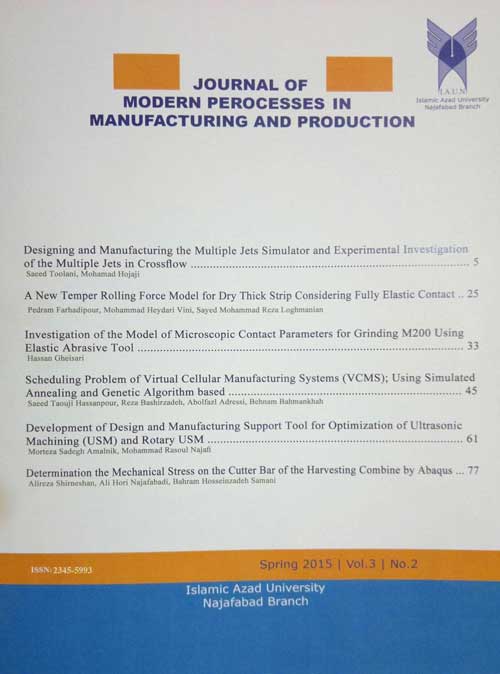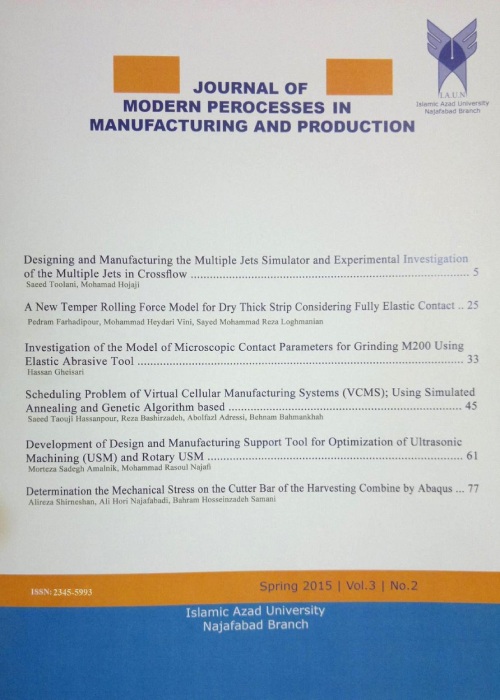فهرست مطالب

Journal of Modern Processes in Manufacturing and Production
Volume:6 Issue: 2, Spring 2017
- تاریخ انتشار: 1396/06/10
- تعداد عناوین: 6
-
Pages 5-19Optimization of turning process is a non-linear optimization with constrains and it is difficult for the conventional optimization algorithms to solve this problem. The purpose of present study is to demonstrate the potential of Imperialist Competitive Algorithm (ICA) for optimization of multipass turning process. This algorithm is inspired by competition mechanism among imperialists and colonies, in contrast to evolutionary algorithmsthat perform the exploration and exploitation in the solution space aiming to efficiently find near optimal solutions using a finite sequence of instructions. To validate the proposed approach, the results of ICA were finally compared with Genetic Algorithm (GA).Based on the results; ICA has demonstrated excellent capabilities such as simplicity, accuracy, faster convergence and better global optimum achievement. The outcome shows the success of ICA in optimizing the machining process indicating that data analysis method developed in this work can be effectively applied to optimize machining processes.Keywords: Imperialist Competitive Algorithm, Machining process, Optimization
-
Pages 21-35One of reasons that researchers in recent years have tried to produce ultrafine grained materials is producing lightweight components with high strength and reliability. There are disparate methods for production of ultra-fine grain materials,one of which is severe plastic deformation method. Severe plastic deformation method comprises different processes, one of which is Parallel tubular channel angular pressing. The aim of this study is optimizing parameters of the noticed process die just by utilizing neural network and genetic algorithm methods that at first for this purpose, by using ABAQUS finite element software, the numerical analysis of the die parameters is performed and the impact of each die parameter on the force of the process and the equivalent strain is examined. Finally, for gaining optimal parameters, MATLAB and neural network optimization methods and genetic algorithm are used. The use of neural network and genetic algorithm illustrated that to achieve the ideal possible situation in order to achieve a flawless super-fine tube, it is imperative to use the friction coefficient of 0.05, tube length of 40 mm, channel angle of 140 degrees and diameter increase difference of 1.5 mm. With such values, strain fluctuations reach 0.23, lowest value, and also the force reaches 0.49 KN and the amount of applied strain reaches its highest value to 2.37.Keywords: Optimization, Neural networks, Genetic Algorithms, Severe Plastic Deformation, Finite Element Method
-
Pages 37-49In this study accumulative roll bonding (ARB) process up to 8 Cycles (equivalent strain of 6.4) at ambient temperature was used in order to improve the mechanical properties of Commercial purity titanium (CP-Ti).Several experiment has been done and Mechanical properties of specimen has been discussed. For investigating optical microscope punching and hardness test were utilized. This is the first study on shear strength of CP-Ti formed by the ARB process. In this study Yield Shear Strength (YSS), Ultimate Shear Strength (USS), elongation, punching energy and hardness were investigated. Results of experiment report that as the number of the ARB process increased, the shear strength increased but after that certain cycle YSS and USS gradually decreased. As well as increasing numbers of ARB cycles, elongation decreased. Result reported that the shear strength of specimen reached to maximum value at certain cycle and afterward due to grain recovery and specimen fracture, it decreased. Experiments indicate that maximum hardnesss and shear strength were obtained in cycle 4 and 6respectively. Furthermore specimen fracture after 8 cycles ARB processing was observed.Keywords: Accumulative Roll Bonding, Titanium, Punching Test, Shear Strength
-
Pages 51-60The widespread application of thermoplastic polymers in different aspects of industries has motivated researchers and companies to improve and upgrade their forming, joining and assembling processes to overcome their limitations. One of the newest joining methods of thermoplastics is friction stir welding which is based on frictional heat generated through contact between a rotating tool and the workpiece. A hybrid thermal assisted friction stir welding approach was proposed in this study for two Poly methyl methacrylate sheets. In this method, the stationary shoe was heated up to the specified temperature and then the FSW tool was gradually plunged toward the clamped sheets. The effects of different process parameters such as rotational and traverse speeds and the heater temperature on the mechanical properties of the joints were studied. Results showed that applying the optimum rotational speeds of 1600 rpm and highest traverse speeds of 12.5 mm/min with the stationary shoe heats up to 70% of base polymer melting temperature which leads to the highest joint performance with strength equal to 95% of PMMA strength.Keywords: Thermoplastic Polymer, Poly Methyl Methacrylate, Thermal Assisted Friction Stir Welding
-
Pages 61-71New trends and the effect of key factors influence the quality of the holes produced by ECM processes. Researchers developed a fuzzy logic controller by adding intelligence to the ECM process. Maintaining optimum ECM process conditions ensures higher machining efficiency and performance. This paper presents the development of a fuzzy logic controller to add intelligence to the ECM process. An experimental ECM drilling was improved through the integration of a fuzzy logic controller into the existing control system. Matlab (Fuzzy Logic Toolbox) was used to build a fuzzy logic controller system, which controls the feed rate of the tool and the flow rate of the electrolyte. The objective of the fuzzy logic controller was to improve machining performance and accuracy by controlling the ECM process variables. The results serve to introduce innovative possibilities and provide potential for future applications of fuzzy logic control (FLC) in ECM. Hybrid controllers that integrate fuzzy logic into the control system allow for "human like" decision-making intelligence to be incorporated into ECM controllers.Keywords: Expert System, Fuzzy Logic, Electrochemical Machining (ECM)
-
Pages 73-92Project managers are grappling with a variety of risks today as a result of increasing complexity and dynamics of projects in different stages of project life cycle. Thus, it seems quite necessary to employ an efficient risk management process that can overcome the shortcomings of traditional methods in order to handle such complexities and reach the optimal project management. This matter is even more important in large scale and complicated projects such as EPC (Engineering, Procurement, and Construction) or turnkey projects where the contractor accepts total responsibilities. One of these new and powerful methods is system dynamics approach that can aid project managers through identification, analysis and evaluation phases. One of the major strategic projects of Isfahan Refinery Development Plan is the third distillation unit and LPG project which is executed through EPC method. The study population consists of 18 experts and project managers examined using census method. To this purpose; a list of potential risks was prepared through literature review in the form of questionnaire to identify risks of mentioned project. Next, by using causal loop diagram (CLD), the cause-effect relationship between risks specified was explained. Applying experts opinions, the primary loop was validated structurally. Several feedback loops were identified and analyzed deeply to determine the influential risks which affect all other risks directly or indirectly. Results show that some risks are more vital and critical for this project which are: project management weaknesses, poor time and cost estimation, poor designs and plans, weaknesses in the procurement, incompetence at site manager and establishing communications between site personals and subcontractors poor performance. In the end, practical policies to improve those situations were presented. To analyze questionnaire data, SPSS was used and to perform system dynamics approach, Vensim software was applied.Keywords: Risk management, Cause, Effect Analysis, Feedback Loop, EPC or Turnkey Projects, Isfahan Refinery Development, Revamping Project


